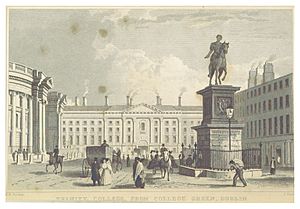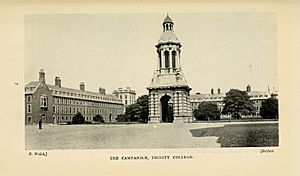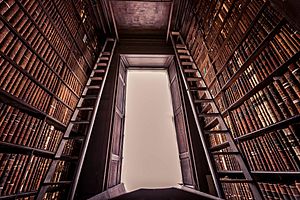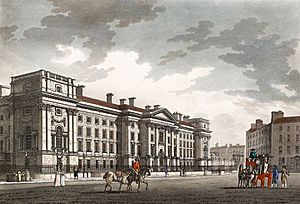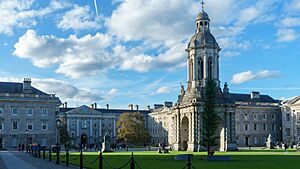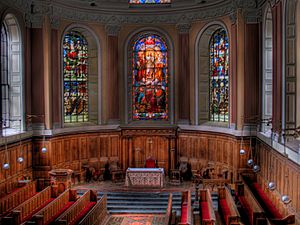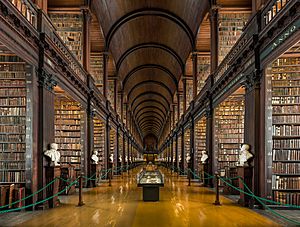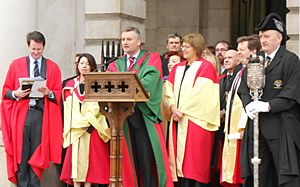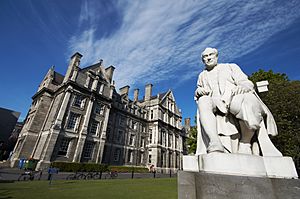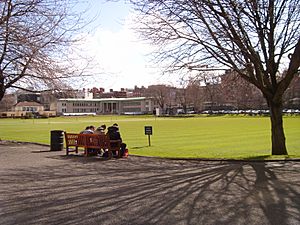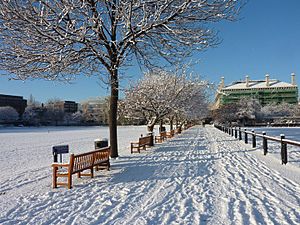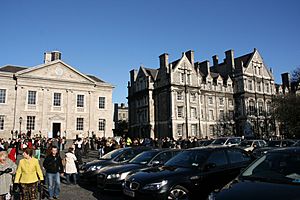Trinity College Dublin facts for kids
Quick facts for kids Trinity College Dublin |
||||||||||||||||
|---|---|---|---|---|---|---|---|---|---|---|---|---|---|---|---|---|
| Collegium Sanctae et Individuae Trinitatis Reginae Elizabethae juxta Dublin | ||||||||||||||||
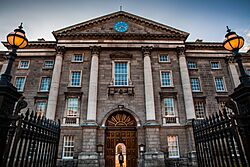
Entrance gate on College Green
|
||||||||||||||||
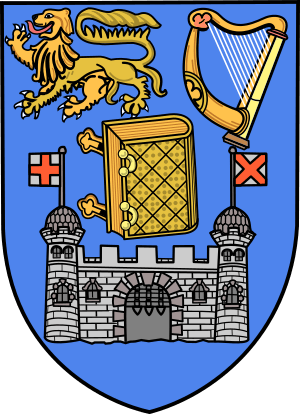
Blazon: Azure, a Bible closed, clasps to the dexter, a lion passant guardant, on the sinister a harp both of the last, and in base a castle with two towers domed, each surmounted by a flag flotant to the sides of the shield argent.
|
||||||||||||||||
|
|
||||||||||||||||
| University | The University of Dublin | |||||||||||||||
| Full name | The Provost, Fellows, Foundation Scholars and the other members of Board of the College of the Holy and Undivided Trinity of Queen Elizabeth near Dublin Irish: Coláiste Thríonóid Naofa Neamhroinnte na Banríona Eilís gar do Bhaile Átha Cliath |
|||||||||||||||
| Latin name | Collegium Sanctae et Individuae Trinitatis Reginae Elizabethae juxta Dublin | |||||||||||||||
| Motto | Perpetuis futuris temporibus duraturam (Latin) | |||||||||||||||
| Motto in English | It will last into endless future times | |||||||||||||||
| Founder | ||||||||||||||||
| Established | 3 March 1592 (via royal charter) | |||||||||||||||
| Named for | The Holy Trinity (via Trinity College, Cambridge) | |||||||||||||||
| Architectural style | Neoclassical architecture (majority) Georgian architecture (oldest buildings) Ruskinian Gothic architecture (minority) |
|||||||||||||||
| Status | Research university Ancient university |
|||||||||||||||
| Colours | Trinity Blue Spindle Dark Abbey Iron |
|||||||||||||||
| Sister colleges | Oriel College, Oxford St John's College, Cambridge |
|||||||||||||||
| President | Linda Doyle (as Provost ex officio) |
|||||||||||||||
| Provost | Linda Doyle | |||||||||||||||
| Undergraduates | 14,085 (2023/24) | |||||||||||||||
| Postgraduates | 6,405 (2023/24) | |||||||||||||||
| Newspaper | Trinity News, The Piranha, The University Times, Icarus | |||||||||||||||
| Affiliations |
|
|||||||||||||||
 |
||||||||||||||||
Trinity College Dublin (Irish: Coláiste na Tríonóide, Baile Átha Cliath) is a famous university in Dublin, Republic of Ireland. It is also known as Trinity College, the University of Dublin (TCD). It was started by Queen Elizabeth I in 1592. Trinity is one of the oldest universities in Great Britain and Ireland.
Trinity College played a big part in Irish writing, especially during the 1700s and 1800s. It helped Dublin become known as a UNESCO City of Literature. The college was built where an old church used to be. For a long time, it was mainly for the ruling Protestant families in Ireland.
Today, Trinity has three main areas of study with 25 different schools. It is connected to other important places like the Royal Irish Academy of Music. Trinity is also part of groups like LERU and the Coimbra Group, which connect top research universities in Europe. Trinity College Dublin has a special partnership with Oriel College, Oxford and St John's College, Cambridge in England. This partnership has been in place since 1636.
The college has many famous spots. These include the Campanile (a bell tower) and the historic Old Library. Trinity's library is very important. It gets a copy of almost every book published in Ireland and the United Kingdom. It has been home to the famous Book of Kells since 1661. It also holds the Brian Boru harp, a national symbol of Ireland, since 1782.
Trinity College is a major tourist spot in Ireland. Over two million people visit it every year. It has also been used as a setting in movies and books. Trinity is home to the world's oldest student society, The Hist, which started in 1770.
Many famous people studied at Trinity. These include writers like Oscar Wilde, Jonathan Swift, and Samuel Beckett. Other notable alumni include the philosopher George Berkeley and the statesman Edmund Burke. Trinity researchers also invented important things like the stethoscope and the hypodermic needle. They also helped discover the electron and performed the first artificial nuclear reaction. Many alumni and teachers have won major awards, including eight Nobel Prizes.
Contents
History of Trinity College
Early Years and Founding
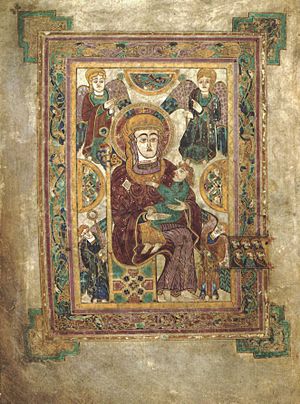
Before Trinity, there was an older university in Dublin from 1320. But it did not last. In 1592, a group of Dublin citizens got permission from Queen Elizabeth I to start Trinity College. It was built on the site of an old church that had been taken down. The city of Dublin gave the land for the college.
The first head of the college was Archbishop Adam Loftus. He named it after his old college at Cambridge. Two years after it started, a few teachers and students began working in the new college. It was small then, with just one square.
In its first 50 years, the college grew. It gained more land and money. New teaching positions were created. The first books for the great library were bought or given as gifts. The rules for studying were set up. Trinity College Dublin has had a special academic partnership with Oriel College, Oxford and St John's College, Cambridge since 1636.
Growth in the 1700s and 1800s
In the 1700s, Trinity College was seen as the university for the Protestant ruling class. The Irish Parliament, which met nearby, gave money to build many of the college's beautiful buildings. The Old Library was started in 1712. Other buildings like the Printing House and Dining Hall followed. By the early 1800s, most of the main square was finished.
The 1800s also saw important changes in professional studies. The law school was updated. Medical studies had been taught since 1711, but they became much stronger after 1800. The Engineering School started in 1842. It was one of the first of its kind in Ireland and Britain.
Becoming Open to All
Trinity College was first set up for Protestants. However, Catholic students were allowed to attend from the very beginning. For a while, to graduate, they had to take an oath that Catholics found difficult. This rule was removed in 1793. This was even before similar changes happened at the University of Cambridge and the University of Oxford.
However, some restrictions remained. Only Protestants could become professors or scholars. In 1845, a Catholic student named Denis Caulfield Heron was not allowed to become a Scholar because of his religion. He appealed, but the decision was upheld. This meant that non-Anglican students could not be elected as Scholars, Fellows, or professors. But within 30 years, all these restrictions were removed. In 1873, all religious tests were abolished, except for those related to studying to become a priest.
In 1871, before all limits on Catholic students were lifted, Irish Catholic bishops advised Catholics not to attend Trinity College. They saw it as a Protestant place. This advice, often called "the ban," lasted for a long time. It was finally lifted by the Catholic Bishops of Ireland in 1970.
Trinity in the 1900s
In 1904, women were allowed to become full members of Trinity College for the first time. Women from Oxford and Cambridge, who could study but not get degrees there, came to Trinity to receive their degrees. They were known as "Steamboat ladies." The money they paid helped fund Trinity Hall, a residence for women students.
Trinity College was attacked during the 1916 Easter Rising. But a small group of students successfully defended it. After Ireland became independent in 1922, Trinity College had a somewhat distant relationship with the new Irish state for a while.
In 1944, the Archbishop of Dublin, John Charles McQuaid, asked Catholics in Dublin to get special permission before going to Trinity. If they did not, they faced serious church penalties. This rule was made national in 1956. Despite this, in 1958, the first Catholic became a Senior Fellow at Trinity.
In 1962, the School of Commerce and the School of Social Studies joined together. In 1969, different schools were grouped into larger areas called Faculties. These included Arts, Business, Engineering, Health Sciences, and Science.
In 1970, the Catholic Church officially lifted its ban on Catholics attending Trinity College. At the same time, Trinity invited a Catholic chaplain to work at the college. Today, there are two Catholic chaplains and one Methodist chaplain.
Student numbers grew a lot in the 1980s and 1990s. This led to more investment in the college. In 1991, Thomas Noel Mitchell became the first Roman Catholic to be elected as the Provost of Trinity College.
Trinity in the 2000s
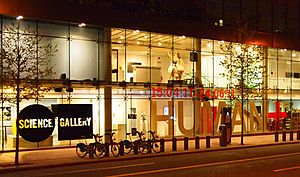
Today, Trinity College is right in the middle of Dublin. In the early 2000s, the college changed its academic structure to use funds better and reduce costs. It reduced the number of faculties. The college also set goals to improve its research globally.
The Hamilton Mathematics Institute was started in 2005. It aims to make Irish mathematics more known around the world. It also helps local math research through workshops and visitor programs.
In 2021, Linda Doyle became the first woman Provost of Trinity College. In 2024, students held protests about the university's business ties to Israel. After five nights, the university said it would not renew these business relationships.
Buildings and Grounds
Trinity College feels calm and peaceful, even though it is in the busy center of Dublin. It is one of Ireland's most popular tourist spots, with over 2 million visitors each year. This is because the main buildings face inwards, forming squares, and there are only a few public entrances. Besides the main campus, Trinity owns other buildings in Dublin. It also has an enterprise center and a botanic garden. The college has been used as a setting in many movies and books.
The main entrance to Trinity College is very grand. It was built in the 1750s using granite and stone. Inside the gateway, you walk over a wooden floor made of oak blocks. This type of paving was used to absorb noise.
Main Campus Features
The main college grounds cover about 47 acres. The buildings offer about 200,000 square meters of space. They range from very old to modern designs. The main entrance is on College Green. The campus is divided by College Park, which has fields for cricket and rugby.
The older part of the college is on the western side. It has the Campanile (bell tower) and beautiful buildings. These include the Chapel, Examination Hall, and the Graduates Memorial Building. The Rubrics is the only part left of the original 1600s buildings. These are all spread across the college's five squares. An old organ case from 1684 is in the Examination Hall. The golden chandelier in the Examination Hall came from the old Irish Parliament House.
The Provost's House is near the main gate, on Grafton Street. Its garden faces into the college. Trinity also has the Douglas Hyde Gallery, a modern art gallery, and the Samuel Beckett Theatre. The theatre hosts many performances and is used by drama students.
The eastern side of the college has science buildings. Most of these are modern. In 2010, Forbes magazine called Trinity one of the 15 most beautiful college campuses in the world.
College Chapel
The current chapel was finished in 1798. It was designed by Sir William Chambers. The chapel shows the college's Anglican history. It has daily and weekly services. Students are no longer required to attend these.
Since 1970, the chapel has been used by different Christian groups. It is now also used daily for Catholic Mass. It was once the only chapel in Ireland shared by all Christian faiths. There is an Anglican chaplain, two Roman Catholic chaplains, and one Methodist chaplain. Special events are often held here.
Behind the chapel is a small cemetery called Challenor's Corner. It is only for burying the Provosts (heads) of the college.
Trinity Library
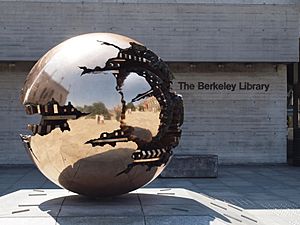
The Library of Trinity College is the biggest research library in Ireland. Because of its history, it is a legal deposit library. This means it legally gets a copy of almost every book published in Great Britain and Ireland. It receives over 100,000 new items every year. The library has about five million books, plus many old papers, maps, and music. Three million books are kept in a special storage building.
The main (Old) Library building is a masterpiece. It was built by Thomas Burgh. It is a huge building that once stood out over the city. Even today, it looks impressive. It started with the college and got a big gift of books from Archbishop James Ussher. The Book of Kells is the library's most famous book. It is in the Old Library, along with other ancient texts. The Old Library, including the Long Room, gets over 900,000 visitors each year. This makes it Dublin's second most visited tourist spot. In the 1700s, the college received the Brian Boru harp, a national symbol of Ireland. It is now kept in the library.
Other library buildings include the Eavan Boland Library, the Lecky Library, and the Ussher Library. The Ussher Library has the Glucksman Map Library, which holds half a million maps. This is the largest map collection in Ireland.
The Berkeley Library was renamed the Eavan Boland Library in October 2024. This happened after people pointed out that George Berkeley had been involved in the slave trade. The Eavan Boland Library is the first building on Trinity's main campus named after a woman.
The library also includes the William Hamilton Science and Engineering Library and the John Stearne Medical Library.
Business School
The Trinity College Business School building was opened in 2019. It cost €80 million to build. The six-story building has an Innovation and Entrepreneurial hub. It also has a large auditorium and modern classrooms. This building connects the city to the main university grounds.
Other College Facilities
Trinity also has buildings and facilities around Dublin. These include departments for politics and sociology on Dame Street. Health Sciences buildings are at St. James's Hospital and Tallaght University Hospital.
The college's botanic garden is in Dartry, about four kilometers south of the main campus. It also owns student residences called Trinity Hall. A new herb garden was opened in 2011.
In 2018, Trinity planned to build new research facilities in Grand Canal Dock. These plans were later made smaller.
Besides College Park, Trinity also has sports grounds in Santry and Crumlin. It has a boathouse in Islandbridge.
How Trinity College Works
Trinity College is led by the Provost. Linda Doyle has been the Provost since August 2021.
The names "University of Dublin" and "Trinity College" usually mean the same thing. Trinity was started like the universities of Oxford and Cambridge in England. These are universities with many separate colleges. But Trinity College was the only college ever created within the University of Dublin. So, the college does the teaching and research, and the University of Dublin gives out the degrees.
Academic Structure
Since 2008, Trinity College has three main academic faculties:
- Arts, Humanities and Social Sciences
- Science, Technology, Engineering, and Mathematics
- Health Sciences
Each faculty has a dean. The faculties are divided into schools. In 2021, there were 24 schools.
Academic Year
The school year has three terms:
- Michaelmas term (October to December)
- Hilary term (January to March)
- Trinity term (April to June)
For most undergraduate courses, teaching happens in the first two terms. Each teaching term lasts 12 weeks. After that, there are three weeks for review and a four-week exam period during the Trinity Term.
The first week of Trinity Term is called Trinity Week. It marks the end of lectures for the year. It includes many sports and academic events. This is when new Scholars and Fellows are announced.
Programs for Younger Students
Since 2014, Trinity College's science department has a program for high school students. It helps talented students study science, technology, engineering, and mathematics (STEM). This program is called the Walton Club, named after Ernest Walton, Ireland's only Nobel Prize winner in Physics.
PhD students at the college teach advanced, college-level subjects to these students. The club focuses on helping students learn to study on their own. It has grown a lot and now also runs camps during school holidays. Students in the club work on projects, like a health-focused electroencephalogram.
College Degrees
Most undergraduate courses take four years. Students are called Junior Freshmen (first year), Senior Freshmen (second year), Junior Sophisters (third year), and Senior Sophisters (fourth year). Trinity's undergraduate admissions are very competitive. About 17% of applicants are accepted.
Students take exams in the Michaelmas and Trinity terms each year. If they pass, they move to the next year. Students who get high scores receive honors degrees.
Most non-professional courses lead to a Bachelor of Arts (BA) degree. Traditionally, after seven years from starting college, BA graduates can pay a fee to upgrade their degree to a Master of Arts.
Trinity also offers a special dual BA program with Columbia University in New York City. Students in certain subjects spend their first two years at Trinity and their last two years at Columbia.
Advanced Studies
Trinity offers many advanced degrees for students who have already completed a first degree. About 29% of students are studying for these advanced degrees.
Trinity College wants to increase the number of students studying for PhDs. It has received a lot of government funding to help with this goal.
How to Get In
For students from Ireland, Britain, and the European Union, applications go through the Central Applications Office (CAO). Trinity College sets the rules for who gets in. Admission is based on how well students do in their school leaving exams.
Trinity also holds its own entrance exams in April. These are similar to the Irish Leaving Certificate exams. For some courses, like medicine, students might need to take extra tests.
Because many students apply, getting into Trinity is very selective. Students need excellent grades. In 2016, about 17.4% of applicants were accepted.
Students from outside the European Union have different application rules. Trinity also has a program called the Trinity Access Programme. It helps students from disadvantaged backgrounds, disabled students, or older students get into the university.
Students from non-European countries can sometimes get in directly if they have certain international exam results. If not, they can take a one-year Foundation Program. This program prepares them for college study. Students need to show good English skills for this program.
Applying for advanced studies is done directly through Trinity College.
Awards and Honors
Entrance Exhibition
Students who get excellent results in their final school exams receive an Entrance Exhibition. This is a prize of book tokens. Students with limited money who receive this award are called Sizars. They get free evening meals at the college.
Foundation Scholarship
Second-year undergraduate students can take the Foundation Scholarship exam. This exam happens in December. On Trinity Monday (the first day of Trinity Term in April), the college announces the new Scholars. To become a Scholar is considered a very important award for students in Ireland.
Students from EU countries who become Scholars get free rooms and meals, a yearly payment, and do not have to pay fees for their scholarship time (which lasts for five years). Scholars from non-EU countries have their fees reduced. Scholars can add "Sch." after their names. They also get to wear special robes.
The Scholarship exam is very challenging. Successful students must be very talented. Many famous people from Trinity were Scholars, including Samuel Beckett and Ernest Walton. The Scholars' dinner is a big event at Trinity. The goal of the Scholarship is to encourage excellence.
The original rules from 1592 said there should be 70 Scholars. Trinity Monday was chosen as the day to announce new Scholars and Fellows. At first, all students were Scholars, but later, other students were admitted.
Until 1856, the exam only covered classical subjects. Later, other subjects were added. Around the 1900s, "Non-Foundation" Scholarships were created. This allowed women to become Scholars, even though old rules seemed to only allow men. Now, women can be Foundation Scholars just like men. Non-Foundation Scholarships are still used to allow more than 70 people to be Scholars if they meet the standards. Both types of Scholars get the same benefits and are equally respected.
University Rankings
| University rankings | |
|---|---|
| Global – Overall | |
| ARWU World | 201–300 (2024) |
| QS World | 75 (2026) |
| THE World | 139 (2025) |
| USNWR Global | =206 (2025) |
Trinity College is ranked 75th in the world by the QS World University Rankings for 2026. It is also ranked 26th in Europe and 1st in Ireland. In 2009, it was ranked 43rd in the world. Trinity is also ranked 139th in the world and 1st in Ireland by the Times Higher Education World University Rankings for 2025.
In 2014, Trinity announced a plan to get back into the top 50 universities worldwide. The dentistry program at Trinity is ranked among the top 51–75 in the world.
| World University Rankings | ||
|---|---|---|
| Year | QS (Change) | THE (Change) |
| 2004 | 87 | N/A |
| 2005 | 111 ( |
N/A |
| 2006 | 78 ( |
N/A |
| 2007 | 53 ( |
N/A |
| 2008 | 49 ( |
N/A |
| 2009 | 43 ( |
N/A |
| 2010 | 52 ( |
N/A |
| 2011 | 65 ( |
76 |
| 2012 | 67 ( |
117 ( |
| 2013 | N/A | 110 ( |
| 2014 | 61 ( |
129 ( |
| 2015 | 71 ( |
138 ( |
| 2016 | 78 ( |
101 ( |
| 2017 | 98 ( |
131 ( |
| 2018 | 88 ( |
117 ( |
| 2019 | 104 ( |
120 ( |
| 2020 | 108 ( |
164 ( |
| 2021 | 101 ( |
155 ( |
| 2022 | 101 ( |
146 ( |
| 2023 | 98 ( |
161 ( |
| 2024 | 81 ( |
134 ( |
| 2025 | 87 ( |
139 ( |
| 2026 | 75 ( |
139 ( |
Student Life at Trinity
Student Societies
As of 2020, Trinity College has over 120 student societies. These groups are managed by the Dublin University Central Societies Committee (CSC).
The three oldest societies are in the Graduates Memorial Building (GMB): the University Philosophical Society (the Phil), the College Historical Society (the Hist), and the College Theological Society (the Theo). The Phil meets on Thursdays, the Hist on Wednesdays, and the Theo on Mondays. Both the Phil and the Hist claim to be the oldest student societies. The Hist was founded in 1770, making it the oldest according to college records.
The Phil has many famous honorary members, including Nobel Prize winners and actors. The Hist has hosted many important speakers, like Winston Churchill.
Other popular societies include:
- Vincent de Paul Society (VDP): Organizes charity activities.
- DU Players: A theater group that puts on many shows.
- DU Film Society: For filmmakers and movie lovers.
- Trinity FM: A student radio station.
- Q Soc – Trinity LGBT society: Ireland's oldest LGBT society.
- The Card and Bridge Society: Holds poker and bridge tournaments.
- Dublin University Comedy Society (DU Comedy): Hosts comedy shows.
- The Dance Society (DU Dance): Offers classes in different dance styles.
Sports Clubs
Trinity has a strong sports tradition with 50 sports clubs. These clubs are part of the Dublin University Central Athletic Club (DUCAC).
Some of the oldest clubs include:
- Dublin University Cricket Club (1835)
- Dublin University Boat Club (1836)
- Dublin University Fencing Club (1774)
- Dublin University Football Club (1854): The world's oldest documented rugby club.
- Dublin University A.F.C. (1883): The oldest surviving soccer club in the Republic of Ireland.
The newest club is the American football team, which joined the Irish American Football League in 2008.
Student Publications
Trinity College has a long history of student publications, from serious newspapers to funny magazines. Most are managed by Trinity Publications.
There are two student newspapers: The University Times and Trinity News. The University Times has won national and international awards. Trinity News is Ireland's oldest student newspaper, started in 1953. It publishes online and in print.
Student magazines include the funny newspaper The Piranha, the general interest T.C.D. Miscellany (one of Ireland's oldest magazines), and the literary Icarus.
Other publications are produced by students in specific subjects, like the Student Economic Review and the Trinity College Law Review.
Trinity Ball
The Trinity Ball is a big yearly event with 7,000 people attending. It is held to celebrate the end of lectures. The Ball is organized by student groups and event promoters. It celebrated its 50th anniversary in 2009.
Students' Union
The Students' Union (SU) represents students to the university. It is run by elected student officers. These officers include the President, Communications Officer, Welfare Officer, Education Officer, and Entertainments Officer. All students can vote in these elections. The SU President, Welfare Officer, and Education Officer are also members of the College Board.
Trinity Traditions
Commons Meals
Commons is a three-course meal served in the College Dining Hall from Monday to Friday. Scholars, Fellows, and Sizars attend, along with other college members and their guests. Commons starts at 6:15 PM. A Latin prayer is said before and after the meal. During Advent, the Chapel Choir sings Christmas carols.
Trinity Week Celebrations
Trinity Week starts each year on Trinity Monday in mid-April. On this day, the college announces the new Fellows and Scholars. An ecumenical service (for different Christian faiths) is held in the College Chapel.
Other Traditions
Trinity has a friendly rivalry with University College Dublin (UCD). Every year, sports clubs and debate societies from both colleges compete in "colours" events.
Famous People from Trinity
Many famous people have studied or worked at Trinity College. Here are some of them:
- Samuel Beckett (Nobel Prize winner for Literature)
- George Berkeley (Philosopher)
- William Campbell (Nobel Prize winner in Medicine)
- William Congreve (Playwright)
- Éamon de Valera (Former President and Taoiseach of Ireland)
- Oliver Goldsmith (Writer)
- William Rowan Hamilton (Mathematician)
- Sheridan Le Fanu (Writer)
- Mairead Maguire (Nobel Peace Prize winner)
- Mary McAleese (Former President of Ireland)
- Mary Robinson (Former President of Ireland)
- Bram Stoker (Author of Dracula)
- Jonathan Swift (Author of Gulliver's Travels)
- Leo Varadkar (Former Taoiseach of Ireland)
- Ernest Walton (Nobel Prize winner in Physics)
- Oscar Wilde (Writer)
- Wolfe Tone (Irish revolutionary)
Images for kids
See also
 In Spanish: Trinity College (Dublín) para niños
In Spanish: Trinity College (Dublín) para niños


